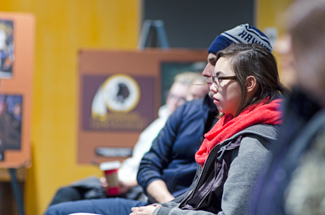North Idaho College students, staff discuss Native American prejudices
The term “redskin” was used in the 19th century to refer to the skin or scalp of a dead Indian used as proof to collect a bounty from the U.S. government, said Evanlene Melting Tallow, American Indian student adviser at North Idaho College.
Melting Tallow said images that portray Native Americans as war-like and primitive are widespread within contemporary American culture.

Nathan Romans | Argonaut
Tayloe Abrahamson talks at the Native American Speak Out Friday November 19, in the SUB Ballroom.
“There is a need to change these mascots,” Melting Tallow said. “We are not costumes, we are people.”
In honor of Native American Heritage Month, the University of Idaho Native American Student Center hosted a panel discussion of discrimination and derogatory images used in art and media.
The grab and war paint of Native Americans has a purpose, said Amanda Lott, a freshman at NIC and a Gros Ventre Assiniboine tribal member. Responding to recent mascot controversies in sports, such as the Washington D.C. Redskins football team, she said the mascots are simplified versions of the culture and do not serve any purpose.
“People do have preconceived ideas about what a Native American is,” Lott said. “It is offensive.”

Nathan Romans | Argonaut
Students, faculty and staff listen to presenters from North Idaho College talk about the stereotypes and issues facing Native American citizens in U.S. society Friday, Nov. 19, in the Student Union Building Ballroom.
Traditional headdresses and war paint are a sacred part of American Indian culture, she said. A headdress is rarely worn and must be earned — each feather in the headdress represents something. When the mascots wear a headdress, these factors have not been taken into account, said Zak Greene, UI junior and member of the Makah Tribe.
“It is like giving a person a purple heart for no reason,” Greene said. “It is generalizing Native Americans as a whole.”
Every tribe has different cultures and beliefs, said Wyatt Calkins, UI sophomore and Nez Perce Indian. For instance, he said while the Navajo culture believes the living should not be in the presence of the dead because the dead have bad energy, the Nez Perce culture does not.
Some companies also use images of Native Americans to promote products unrelated to Native American culture, said Taylor Abrahamson, NIC junior and a Coeur d’Alene Indian. He said Land O’ Lakes butter and Arizona Tea are examples of this kind of marketing.
The Arizona Tea Pina Colada bottle has a Native American with a headdress and Land O’ Lakes butter shows a Native American woman holding the product. Abrahamson said it’s concerning because Native Americans don’t have anything to do with butter.
“We don’t want these images out there,” Abrahamson said. “That is not who we are.”
Native Americans face prejudices from more than just their stereotypes. Life at UI presents its prejudices, said Sydel Samuels, director of the Native American Student Center. Samuels said she speaks with Native American students daily.

Nathan Romans | Argonaut
Students, faculty and staff listen to presenters from North Idaho College talk about the different stereotypes and issues facing the image of the Native American citizen in U.S. society Friday, November 19, in the Sub Ballroom.
“Students experience (the prejudices) more directly,” Samuels said. “(It is mostly) ignorance and bias.”
Samuels said although instances are rare, issues range from people not understanding Native American culture to students being told their native language is not important.
“It is our job to educate the UI community about Native American issues,” Samuels said.
Graham Perednia can be reached at [email protected]

